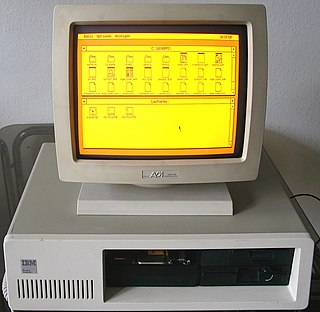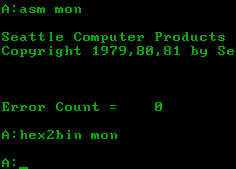
Gary Arlen Kildall was an American computer scientist and microcomputer entrepreneur who created the CP/M operating system and founded Digital Research, Inc. (DRI). Kildall was one of the first people to see microprocessors as fully capable computers, rather than equipment controllers, and to organize a company around this concept. He also co-hosted the PBS TV show Computer Chronicles. Although his career in computing spanned more than two decades, he is mainly remembered in connection with his development of the CP/M operating system, an early multi-platform microcomputer OS that has many parallels to the later MS-DOS used on the IBM PC.

CP/M, originally standing for Control Program/Monitor and later Control Program for Microcomputers, is a mass-market operating system created in 1974 for Intel 8080/85-based microcomputers by Gary Kildall of Digital Research, Inc. Initially confined to single-tasking on 8-bit processors and no more than 64 kilobytes of memory, later versions of CP/M added multi-user variations and were migrated to 16-bit processors.

GEM is an operating environment which was created by Digital Research (DRI) since 1984 for use with the DOS operating system on Intel 8088 and Motorola 68000 microprocessors.

Digital Research, Inc. was a company created by Gary Kildall to market and develop his CP/M operating system and related 8-bit, 16-bit and 32-bit systems like MP/M, Concurrent DOS, FlexOS, Multiuser DOS, DOS Plus, DR DOS and GEM. It was the first large software company in the microcomputer world. Digital Research was originally based in Pacific Grove, California, later in Monterey, California.
MP/M is a discontinued multi-user version of the CP/M operating system, created by Digital Research developer Tom Rolander in 1979. It allowed multiple users to connect to a single computer, each using a separate terminal.

In computing, dir (directory) is a command in various computer operating systems used for computer file and directory listing. It is one of the basic commands to help navigate the file system. The command is usually implemented as an internal command in the command-line interpreter (shell). On some systems, a more graphical representation of the directory structure can be displayed using the tree command.

86-DOS is a discontinued operating system developed and marketed by Seattle Computer Products (SCP) for its Intel 8086-based computer kit. Initially known as QDOS, the name was changed to 86-DOS once SCP started licensing the operating system in 1980.

Multiuser DOS is a real-time multi-user multi-tasking operating system for IBM PC-compatible microcomputers.
Shepardson Microsystems, Inc. (SMI) was a small company producing operating systems and programming languages for CP/M, the Atari 8-bit family and Apple II computers. SMI is most noted for the original Apple II disk operating system, Atari BASIC, and Atari's disk operating system. Shepardson Microsystems was founded by Robert Shepardson in Saratoga Springs, New York.
A source-to-source translator, source-to-source compiler, transcompiler, or transpiler is a type of translator that takes the source code of a program written in a programming language as its input and produces an equivalent source code in the same or a different programming language. A source-to-source translator converts between programming languages that operate at approximately the same level of abstraction, while a traditional compiler translates from a higher level programming language to a lower level programming language. For example, a source-to-source compiler may perform a translation of a program from Python to JavaScript, while a traditional compiler translates from a language like C to assembler or Java to bytecode. An automatic parallelizing compiler will frequently take in a high level language program as an input and then transform the code and annotate it with parallel code annotations or language constructs.
MSX-DOS is a discontinued disk operating system developed by Microsoft for the 8-bit home computer standard MSX, and is a cross between MS-DOS 1.25 and CP/M-80 2.
A self-booting disk is a floppy disk for home or personal computers that loads directly into a standalone application when the system is turned on, bypassing the standard operating system. This was common in the late 1970s to early 1990s, with video games being the type of application most commonly distributed using this technique.
Cromemco was a Mountain View, California microcomputer company known for its high-end Z80-based S-100 bus computers and peripherals in the early days of the personal computer revolution.

In computing, ren is a command in various command-line interpreters (shells) such as COMMAND.COM, cmd.exe, 4DOS, 4NT and Windows PowerShell. It is used to rename computer files and in some implementations also directories. It can also move a file to a new path, if it is on the same device. It is analogous to the Unix mv command. However, unlike mv, ren cannot be used to move files, as a new directory for the destination file may not be used. Alternatively, move may be used if available. On versions of MS-DOS that do not support the move command, the user would simply copy the file to a new destination, and then delete the original file. A notable exception to this rule is DOSBox, in which ren may be used to move a file, since move is not supported.

In computing, type is a command in various command-line interpreters (shells) such as COMMAND.COM, cmd.exe, 4DOS/4NT and Windows PowerShell used to display the contents of specified files on the computer terminal. The analogous Unix command is cat.
FlexOS is a discontinued modular real-time multiuser multitasking operating system (RTOS) designed for computer-integrated manufacturing, laboratory, retail and financial markets. Developed by Digital Research's Flexible Automation Business Unit in Monterey, California, in 1985, the system was considered to become a successor of Digital Research's earlier Concurrent DOS, but with a new, modular, and considerably different system architecture and portability across various processor families. Still named Concurrent DOS 68K and Concurrent DOS 286, it was renamed into FlexOS on 1 October 1986 to better differentiate the target audiences. FlexOS was licensed by several OEMs who selected it as the basis for their own operating systems like 4680 OS, 4690 OS, S5-DOS/MT and others. Unrelated to FlexOS, the original Concurrent DOS system architecture found a continuation in successors like Concurrent DOS XM and Concurrent DOS 386 as well.

Z-2 is a series of microcomputers made by Cromemco, Inc. which were introduced to the market in the middle to late 1970s. They were S-100 bus machines powered by the Zilog Z80 processor and typically ran on the CP/M operating system.

DOS is a platform-independent acronym for Disk Operating System which later became a common shorthand for disk-based operating systems on IBM PC compatibles. DOS primarily consists of Microsoft's MS-DOS and a rebranded version under the name IBM PC DOS, both of which were introduced in 1981. Later compatible systems from other manufacturers include DR DOS (1988), ROM-DOS (1989), PTS-DOS (1993), and FreeDOS (1998). MS-DOS dominated the IBM PC compatible market between 1981 and 1995.
The Durango F-85 was an early personal computer introduced in September 1978 by Durango Systems Corporation, a company started in 1977 by George E. Comstock, John M. Scandalios and Charles L. Waggoner, all formerly of Diablo Systems. The F-85 could run its own multitasking operating system called DX-85M, which included an integral Indexed Sequential (ISAM) file system and per-task file locking, or alternatively CP/M-80. DX-85M utilized a text configuration file named CONFIG.SYS five years before this filename was used for a similar purpose under MS-DOS/PC DOS 2.0 in 1983.











